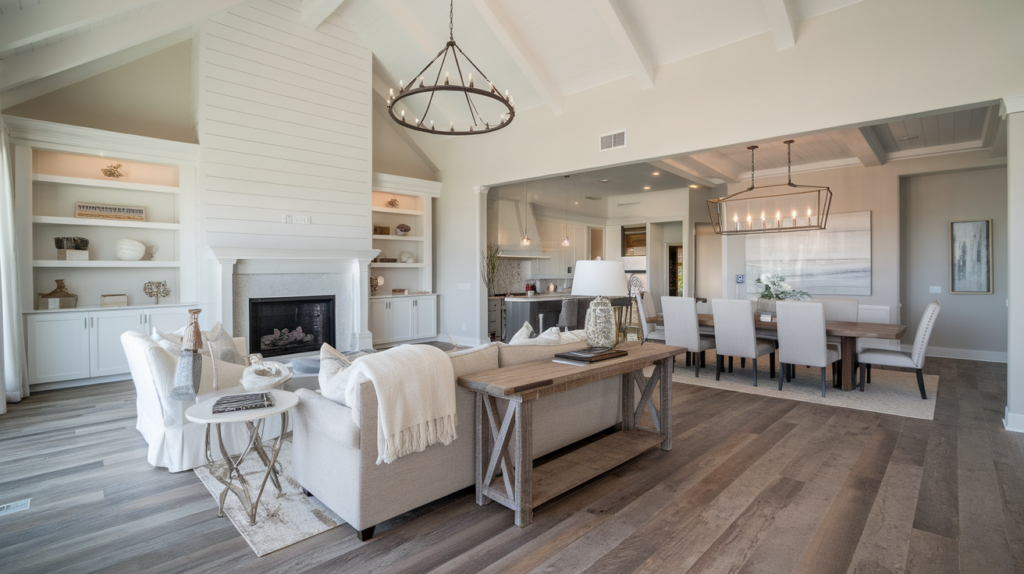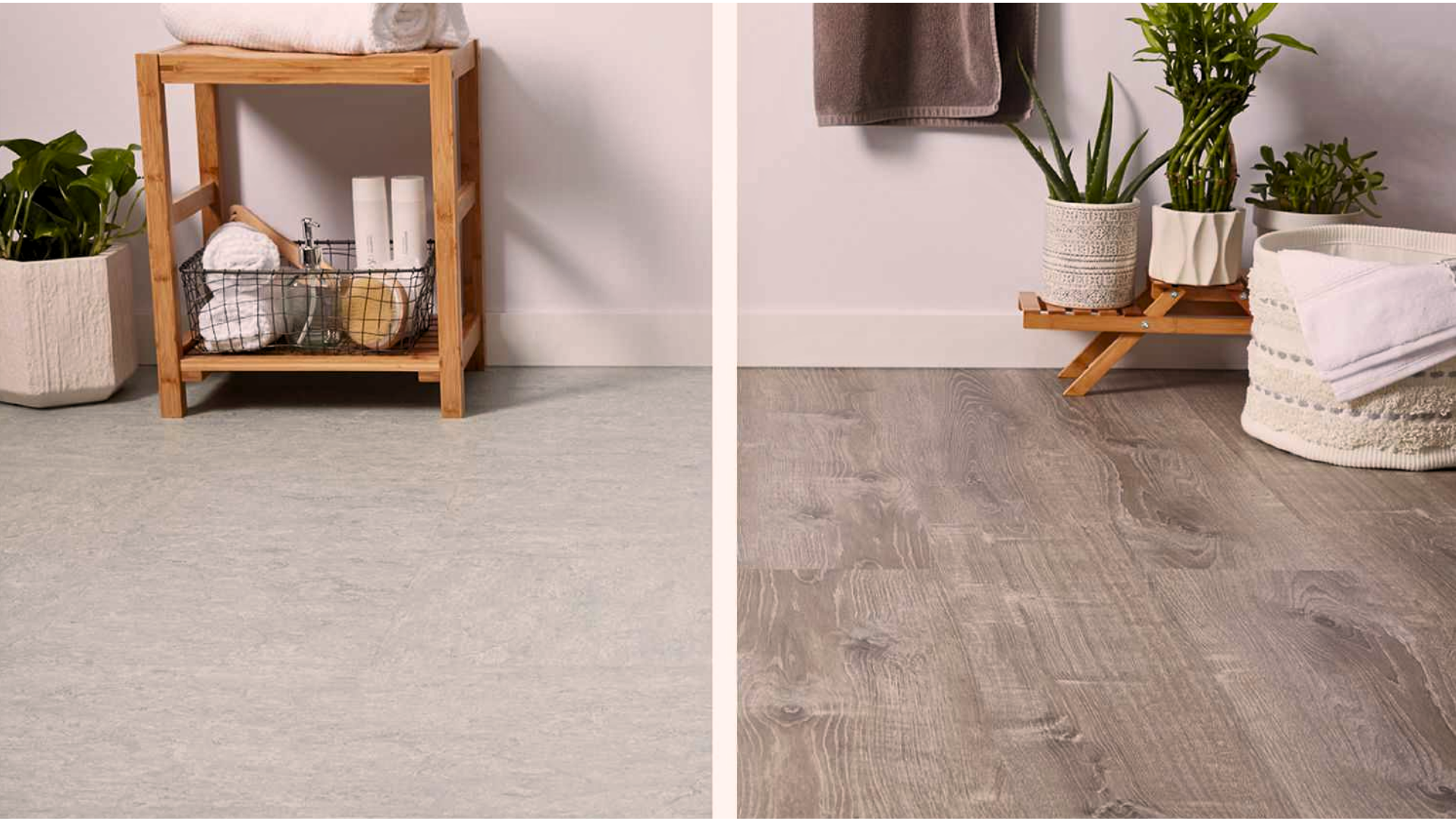Thinking about new flooring and stuck between vinyl and linoleum? You’re not alone. Most homeowners get these two mixed up, assuming they’re basically the same thing. But they’re not!
In this guide, I’ll break down exactly what makes vinyl and linoleum different. I’ll walk you through:
- What each material really is
- How they look and feel
- Their durability
You’ll find which floor covering matches your home’s needs, budget, and style. Trust me, by the end of this blog, you’ll be a flooring expert who can confidently choose between vinyl and linoleum.
Let’s solve this flooring puzzle together.
What Are Vinyl and Linoleum Made Of?
When I first began researching flooring, I was surprised to discover the significant differences between vinyl and linoleum. Spoiler alert: They’re nothing alike under the surface.
Vinyl: Vinyl flooring is 100% manufactured. Consider plastic, specifically polyvinyl chloride (PVC). It’s born in a factory, created from synthetic materials that blend chemicals and petroleum products.
Linoleum: This is the eco-friendly cousin in the flooring world. It’s crafted from natural ingredients like linseed oil, cork dust, wood flour, natural pigments, and limestone.
Linoleum has been around since the 1800s, while vinyl is a relative newcomer. Each material brings its own personality to your floor.
What Is Linoleum Flooring?

Linoleum flooring is a durable, eco-friendly material composed of natural ingredients, including linseed oil, cork dust, wood flour, and resin.
It’s been around for over a century and is known for its resilience, flexibility, and classic style.
Linoleum comes in sheets, tiles, or planks and offers a smooth surface that’s soft underfoot.
It’s naturally resistant to water, stains, and bacteria, making it a great choice for kitchens, bathrooms, and other high-traffic areas.
Unlike vinyl, which is synthetic, linoleum is biodegradable and low in VOCs, making it a greener option.
It also comes in a wide range of colors and patterns, so it’s easy to match with any decor. With proper care, linoleum can last 20–40 years, making it a smart, long-term flooring solution.
What Is Vinyl Flooring?

Vinyl flooring is a popular, affordable option made from synthetic materials like PVC (polyvinyl chloride).
It’s known for being water-resistant, low-maintenance, and easy to install, which makes it a top choice for busy homes.
You can find vinyl in planks, tiles, or large sheets. Some styles even mimic the look of wood, stone, or ceramic, without the higher cost or upkeep.
Many people like how soft it feels underfoot compared to harder surfaces.
Vinyl is also scratch- and stain-resistant, making it ideal for kitchens, bathrooms, and high-traffic areas. Some types come with a padded layer underneath for extra comfort and noise reduction.
Overall, vinyl flooring is a durable, stylish, and budget-friendly option that works well in just about any room.
Key Differences Between Vinyl and Linoleum
Both vinyl and linoleum are popular flooring options, but they differ in many ways. Below is a breakdown to help you compare them side by side:
1. Appearance and Design Options
When I started my flooring research, I found a wild world of design possibilities. Vinyl and linoleum? They’re like twins with completely different personalities.
Vinyl
Vinyl is the shape-shifter. Want wood-look floors without cutting down a single tree? Check. Craving stone-like textures without quarrying? Done.
This material can mimic literally anything. High-gloss, matte, weathered look – vinyl serves up design dreams on a silver platter.
Most homeowners love how it can transform a room without breaking the bank.
Linoleum
Linoleum plays a different game. Its patterns run deep – literally through the entire material. No fake surfaces here. Think subtle, earthy tones.
Muted colors that whisper instead of shouting. If vinyl is a loud rock concert, linoleum is a smooth jazz performance.
The bottom line? Vinyl wins variety. Linoleum wins authenticity. Your space, your choice.
2. Lifespan and Durability
When I first compared floor lifespans, I was shocked. Not all floors are created equal, and the durability difference is mind-blowing.
Vinyl
Temporary Resident Vinyl floors typically last 10 to 20 years. Think of them like a reliable rental car – good, but not for the long term.
Their survival depends on the thickness of the wear layer. Thicker layers? Longer life.
High-traffic zones like hallways and kitchens will wear vinyl down faster. Cheaper vinyl might look good initially, but it’ll show its age quicker than you can say “replacement.”
Linoleum
Linoleum handles wear and tear well. 30 to 40 years? Yes, really. This floor is the marathon runner of the flooring world.
With proper care, it outlasts most household appliances. Its scratch resistance is legendary.
Low-maintenance spaces like home offices or bedrooms? Linoleum will look pristine decades later.
Quick Durability Breakdown
| Floor Type | Lifespan | Traffic Tolerance | Wear Resistance |
|---|---|---|---|
| Vinyl | 10-20 years | Moderate | Good for light to medium traffic |
| Linoleum | 30-40 years | Excellent | Superior durability |
| Best For | Rentals, temporary spaces | High-traffic areas, long-term homes | Busy households, commercial spaces |
3. Water, Heat, and Chemical Resistance
When I delved into floor resistance, I learned a complex and diverse world of differences. Vinyl and linoleum? They’re like two siblings with totally different superpowers.
Vinyl
Vinyl is completely waterproof, making it a great choice for bathrooms. It handles spills, splashes, and puddles without any trouble.
Laundry rooms, kitchens, bathrooms – vinyl stands guard like a superhero. Cleaning is a breeze – wipe and go. No special treatments, no fuss.
Linoleum
Linoleum plays a different game. It loves heat but fears water. Standing moisture? Not its jam.
You’ll need to wipe spills quickly. Gentle cleaners are a must. Think of it like a high-maintenance plant that needs careful attention.
Quick Resistance Rundown
| Resistance Category | Vinyl | Linoleum |
|---|---|---|
| Water Protection | Fully Waterproof | Sensitive to moisture |
| Heat Tolerance | Good | Excellent |
| Cleaning Ease | Super Simple | Requires Gentle Care |
| Chemical Resistance | High | Moderate |
| Stain Resistance | Excellent | Good |
Your floor’s performance depends on how you treat it. Maintenance matters! Seal your linoleum occasionally to boost its water resistance. Your floor will thank you.
4. Cost Comparison
When I started comparing flooring costs, my wallet perked up and started paying attention. Spoiler alert: Not all floors hit your bank account the same way.
Vinyl
Vinyl is like the smart shopper of flooring. Cheap and cheerful, it ranges from $1 to $5 per square foot. Installation?
Often a DIY dream. Most homeowners can tackle this with basic tools and a YouTube tutorial. If you’re watching every penny, vinyl whispers sweet nothings to your budget.
Linoleum
Linoleum plays the slow and steady game. Initial cost? $2 to $7 per square foot. Sounds higher, right?
But here’s the twist – this floor can outlast multiple vinyl replacements. Professional installation is typically recommended, adding to upfront costs.
Budget Breakdown
| Category | Vinyl | Linoleum |
|---|---|---|
| Upfront Cost | Cheaper | Higher initial investment |
| Long-Term Value | Less durable | Saves money over time |
| DIY Installation | Easy, low-cost | More complex, professional help is recommended |
| Replacement Frequency | More often | Less frequent |
| Maintenance Cost | Low | Moderate |
| Lifetime Value | Good | Excellent |
Pro tip: Sometimes spending a bit more upfront means massive savings down the road. Choose wisely!
5. Environmental Impact
When I started digging into floor materials, I learned about a fascinating environmental battle. Vinyl and linoleum are like eco-warriors with completely different missions.
Vinyl
Vinyl is petroleum-based, synthetic, and non-biodegradable, which means it doesn’t break down naturally over time and can hurt the environment if not properly recycled or disposed of.
Manufacturing releases chemicals that make environmental experts raise eyebrows. Some newer vinyl options try to be greener, but they’re still far from perfect.
Linoleum
Linoleum is made from natural materials like linseed oil, cork dust, and wood flour. It doesn’t contain toxic chemicals or petroleum-based products.
When it reaches the end of its life, linoleum can break down naturally, making it a more eco-friendly flooring option.
6. Health Considerations
| Health Factor | Linoleum | Vinyl |
|---|---|---|
| Antimicrobial Properties | Naturally occurring | Requires chemical treatment |
| Chemical Off-Gassing | Minimal | Potential health concerns |
| Allergy Friendliness | Excellent | Good |
| Toxicity Levels | Low | Moderate to High |
| Indoor Air Quality | Supports a healthy environment | May release volatile organic compounds |
Pro tip: Your floor is more than just a surface. It’s part of your home’s health ecosystem. Your floor choice impacts more than just looks. It affects your home’s health and the planet’s future.
Conclusion
When I started this journey, flooring felt like a complicated puzzle. Now? It’s crystal clear.
Vinyl and linoleum aren’t just materials – they’re solutions waiting to solve your home’s unique challenges. Vinyl shines in wet spaces. Linoleum wins for long-term durability.
Your perfect floor depends on your lifestyle. Busy family? Vinyl might be your superhero. Eco-conscious homeowner? Linoleum could be your soulmate.
Don’t just read. Touch samples, walk on them, and imagine them in your space. Flooring is personal. What works for your neighbor might not work for you.
The right floor isn’t about trends. It’s about your comfort, your budget, and your home.
Ready to change your space?

